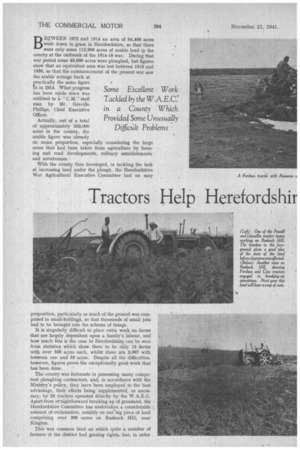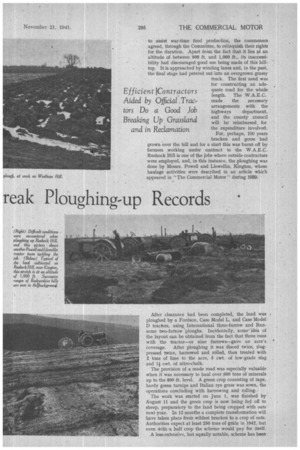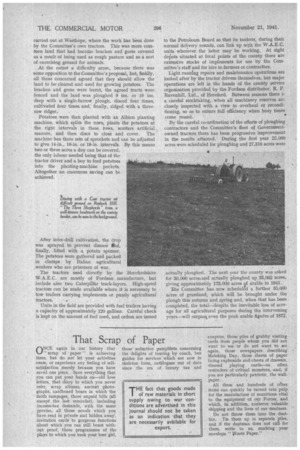Tractors Help Herefordshir reak Ploughing-up Records
Page 26

Page 27

Page 28

If you've noticed an error in this article please click here to report it so we can fix it.
BET:VVEEN 1872 and 1914 an area of 84,466 acres went down to grass in Herefordshire, so that there were only some 112,000 acres of arable land in the county at the outbreak of the 1914-18 war. During that war period some 40,000 acres were ploughed, but figures show that an equivalent area was lost between 1918 and 1939, so that the commencement of the present war saw the arableacreage back at practically the same figure
s in 1914. What progress has been made since was outlined to a " C.M." staff man by Mr. Greville , Phillips, Chief Executive Officer.
Actually, out of a total of approximately 500,000 acres in the county, the arable figure was already no mean proportion, especially considering the large areas that had been taken from agriculture by housing and road developments, military establishments and aerodromes.'
DifficUlt Problems
With the county thus developed, in tackling the task of increasing land under the plough, the Herefordshire War Agricultural Executive Committee had no easy proposition, particularly as much of the ground was comprised in small-holdings, so that thousands of small jobs had to be brought into the scheme of things.
It is singularly difficult to place extra work on farms that are largely dependent upon a family's labour, and how much this is the case in Herefordshire can be seen from statistics which show there to be only 13 farms with over 500 acres each, whilAt there are 3,907 with between one and 50 acres. Despite all the difficulties, however, figures prove the exceptionally good work that has been done.
The county was fortunate in possessing many competent ploughing contractors, and, in accordance with the Ministry's policy, they have been employed to the best advantage, their efforts being' supplemented, as necessary, by 26 tractors operated directly by the W.A.E.C. Apart from straightforward breaking up of grassland, the Herefordshire Committee has undertaken a considerable amount of reclamation, notably on one' big piece of land comprising over 300 •acres on Rushock Hill, near Kington.
This was common land on which quite a number of farmers ii the district had grazing rights, but, in order
to assist war-time food production, the commoners agreed, through the Committee, to relinquish their rights for the duration. ,Apart from the fact that it lies at an altitude of between 800 ft. and 1,400 ft., its inaccessibility had discouraged good use being made of this hilltop. It is approached by winding lanes and, in the past, the final stage had petered out into an overgrown grassy
track. The first need was for constructing an ade quate road for the whole length. The W.A.E.C.
made the necessary arrangements with the highways department, and the county council will be reimbursed, for the expenditure involved.
For, perhaps, 100 years
bracken and gorse had grown over the hill and for a start this was burnt off by farmers working under contract to the W.A.E.C. Rushock Hill is one of the jobs where outside contractors were employed, and, in this instance, the ploughing was done by Messrs. Powell and Llewellin, Kington, whose haulage activities were described in an article which appeared in "The Commercial Motor" during 1034.
After clearance had been completed, the land was ploughed by a Fordson, Case Model L, and Case Model D tractors, using, International three-furrow and Ransome two-furrow ploughs. Incidentally, some' idea of the layout can be obtained 'from the fact that three runs with the tractor—or nine furrows—gave an acre's coverage. After ploughing it was disced twice, mgpressed twice, harrowed and rolled, then treated with 2 tons of lime to the acre, 5 cwt. of low-grade slag and l cwt. of nitro-chalk.
The provision of a made road was especially valuable when it was necessary to haul over 600 tons of minerals up to the 800 ft. level. A green crop consisting of rape, hardy green turnips and Italian rye grass was sown, the operations concluding with harrowing and rolling.
The work was started on June 1, was finished by August 11 and the green crop is now being fed off to sheep, preparatory to the land being cropped with oats next year. In 12 months a complete transformation will have taken place from wildest bracken to a crop of oats. Authorities expect at least 250 tons of grain in 1942, but even frith-a half crop the scheme would pay for itself.
A less-extensive, but equally notable, scheme has been carried out at Westhope, where the work has been done by the Committee's own tractors. This was more common land that had become bracken and gorse covered as a result of being used as rough pasture and as a sort of exercising ground for animals.
At the outset a difficulty arose, because there was some opposition to the Committee's proposal, but, finally, all those concerned agreed that they should allow the land to be. cleared and used for growing potatoes. The bracken and gorse were burnt, the agreed tracts were fenced and the land was ploughed 9 ins. or 19 ins. deep with a single-furrow plough, disced four times, cultivated lour times and: finally, ridged with a threerow ridger.
Potatoes were then planted with an Albion planting machine, which splits the rows, plants the potatoes at the right intervals in these tows, scatters artificial manure, and then discs to close. and cover. The machine 'has three sets of sprockets and can be adjusted to give 14-in., 16-in. or 18-in. intervals. By this means
two or three acres a day can be covered, the only labour needed being that of the tractor driver and a boy to feed potatoes into the planting-machine pockets. Altogether an enormous saving can be achieved.
After inter-drill cultivation, the drop was sprayed to prevent disease mid, finally, lifted with a potato spinner. The potatoes were gathered and packed in clamps by Italian agricultural „workers who are prisoners of war. The tractors used directly by the Herefordshire W.A.E.C. are mostly of Fordson manufacture, but include also two Caterpilth.r track-layers. High-speed tractors can be made available where it is necessary to tow trailers carrying implements or purely agricultural tractors. • • Units in the field are provided with fuel trailers having a capacity of approximately 120 gallons. Careful check is kept on the amount of fuel used, and orders are issued
to the Petroleum Board so that its tankers, during their normal delivery rounds, can link up with the W.A.E.C. units wherever the latter may be working. At eight depots situated at fdcal points of the county there are extensive stocks of implements for use by the Committee's staff and for hire to farmers or contractors.
Light running repairs and maintenance operations are looked after by the tractor drivers themselves, but major operations are left in the hands of the county service organization provided by the Fordson distributor, R. P. Ravenhill, Ltd., of Hereford. Between seasons there
a careful stocktaking, when all machinery reserves are closely inspected with a view to overhaul or reconditioning, so as to ensure full effiCiency when busy times
come round. •
By the careful co-ordination of the efforts of ploughing . contractors and the Committee's fleet of Governmentowned tractors there has been progressive improvement in the results attained. During the first year 25,000 .acres were scheduled for ploughing and 27,318 acres were
actually ploughed. The next year the county was asked for 30,000 acres. and actually ploughed up 33,062 acres, giving approximately 173,000 acres of amble in 1941.
The Committee has -now scheduled a further 35,000 acres of grassland, which will be brought under the plough this autumn and spring and, when that has been completed, the total—despite the inevitable loss of acreage for all agricultural purposes during the intervening years—will surpasa even the peak arable figures of 1872.




















































